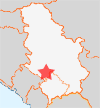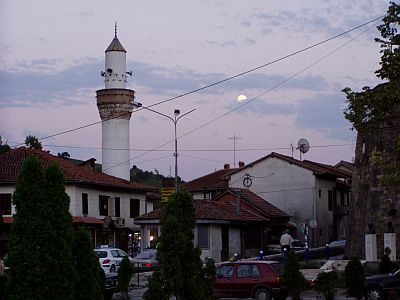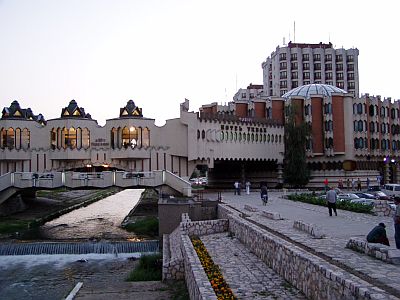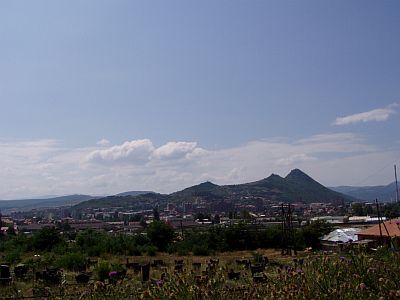Official Name
Нови Пазар (Novi Pazar). "Novi" is a Slavic word which means "new" (deriving from Latin), while "Pazar" is Persian - and in English better known as "bazaar", so the city name simply translates as New Market. Ottomans gave the name to the city - at that time first called "Yeni Pazar" (Yeni = new). This is not a rare name in the Balkans - there's also a larger town in →Bulgaria called Novi Pazar (west of →Varna).
Location

| ||
| Novi Pazar |
Novi Pazar lies in the southwest of Serbia and is only a few kilometres away from the →Kosovo. To the Serbian capital →Belgrad it's around 290 km to the north. The town is surrounded by mountains and occupies a valley in an altitute of almost 500 m. The small river Raška runs through the town.
Population
The town itself has about 55,000 inhabitants, the larger town area including some villages in the vicinity has 86,000 inhabitants. Almost 80% of them are Bosniak Muslims. According to various estimates, some 6,000 refugees from →Bosnia-Hercegovina and the →Kosovo still live in the city.
Orientation
 | ||
| View on the centre of Novi Pazar |
Old and new lie close to each other in Novi Pazar. The town covers a long valley, sprawling in every direction. The bus terminal is around 10 minutes on foot away from the centre and right at the main road ul. Nemanie. The latter runs straight forward to the south. When approaching the centre, a massive and somewhat strange looking concrete block stretches on the right side of the street. The area between that very same building and the small river marks the centre of town.
Nemanie rd. leads to a small bridge over the river Rashka. Behind the river, on the right side, is a small hill with the ruins of a fortress on top of it - now used as a park. To the left stands a small mosque. Behind the mosque starts the old Bazaar, which also features an original Hamam (Turkish bath) and some more mosques. The centre is rather compact - everything is within walking distance.
History
Novi Pazar is a comparetively new town - founded in 1451 by the Ottomans. The historic document describing the foundation of town also mentions Isa-beg Isakovic - the same who founded →Sarajevo. Novi Pazar is much younger then for example Stari Ras, which is nearby and was nothing less then the first capital of Serbia. This means that Novi Pazar is right in the middle of the old Serbian heartland. Later on, many Serbs flew from the area to the plains in the north (see →History of Serbia for more details).
Yeni Pazar, as it was called then, quickly developed to a rich trade centre, because it was built at the crossroads of several important trading routes. Around the 17th century, Novi Pazar was one of the largest towns in the Balkans. At the same time, it was the capital of a Sancak (Sandshak) - that was the name for the large districts in the Ottoman empire. Later, this term developed into Sandžak, which is still used for the entire region around the town. This region not only covers wide parts of Southwestern Serbia but also parts of →Montenegro, →Bosnia-Hercegovina and borders the →Kosovo. Traditionally, many Bosniaks live in the area - including Novi Pazar. The majority is muslim, and so it's not surprising to find many mosques around. Recent wars in neighbouring Bosnia and Kosovo didn't do the region much good - many refugees flooded the town and it's vicinity. At the same time, pressure on Muslims living in Serbia mounted - many Muslims were ousted - from the police for example - just for their religion and/or ethnicity. Some citizens I talked to mentioned that the situation in town is still precarious when it comes to the relation between the several ethnic groups.
Getting there / transportation
Novi Pazar is not connected to the railroad network. There's only the bus. Several buses a day run to and from →Belgrade via Kragujevac and Kraljevo. The trip takes around 5 hours and costs 600 JDin (about € 7.5). There are also buses running from Belgrade via the Montenegrin capital Podgorica all the way to →Bar at the Adriatic Sea. Those buses mostly stop in Novi Pazar, too.
There is a direct bus running all the way to the Macedonian capital →Skopje - to get there, the bus crosses the Kosovo, where it stops in →Kosovska Mitrovica and →Prishtina. The bus leaves Novi Pazar at 12:40 pm and needs around 3 hrs to Prishtina the fare to the capital of Kosovo is 420 JDin (€ 5).
Attention: Travelling from Novi Pazar to the Kosovo or further to →Macedonia is no problem. Vice versa it can be problematic: Since the passport won't be stamped when entering the Kosovo (and there is no immigration procedure between Kosovo and Serbia), Serbia considers this way of entering the country illegal, so it might cause a stir when leaving Serbia again.
Novi Pazar is a surprisingly vibrant town with two different faces - there's the southern part pf town with its minarets, the old bazaar district and the ruins of the fortress right south of the river and there's the area north of the river, which looks like the result of a contest in concrete architecture. Since there are no tourists or travellers at all, this city gives a fascinating insight in what Serbia also looks like. Travelers who know other Serbian cities will be surprised when they see Novi Pazar - this place is almost oriental in its appearance - though it's in Serbian heartland. However, travelers familiar with the Balkans definitely won't be surprised by the homicidal traffic. The old bazaar district south of the mosque at the small bridge is particularly interesting. The narrow lanes and tiny buildings - many of them unfortunately in a dilapidated state - tell a lot about the long Ottoman supremacy in Serbia. Right in the middle of the old town stands a original Hamam (Turkish Bath) - but unfortunately, this building is in a miserable condition, too.

| ||
| Novi Pazar: The small mosque opposite the fortress |
The ruins of the old fortress and the city park around and behind the fortress make for a pleasant walk. North of it, opposite the river, starts the modern town with its idiosyncratic architectural style. The first eye-catching structure is the Hotel Vrbak (see picture below and →Accommodation). The drip-castle-like building stretches along and even over the river and is hard to judge - is it contemporary art? is it just ugly? At least I couldn't tell...

| ||
| Unusual architecture in the centre: Hotel Vrbak |
The same can be said about the long, tall and dark block stretching along Boulevard Avnoja further to the north. It's a huge apartment block, with the first floor used for stores and restaurants. It's clear that this building had already seen better times as well. The most vibrant area of the town - at night and day - is the area between the above-mentioned Hotel Vrbak and Boulevard Avnoja: Several teahouses, restaurants and cafés concentrate in this small area. The 28 Nov street in the same area is occasionally used as a nocturnal book bazaar.

| ||
| Unusual architecture part II: At Blvd. Avnoja |
Novi Pazar is a fascinating town and worth stopping by - this is a completely different Serbia, compared to central and northern Serbian places. But this is Serbia as well. And there's much to explore in the area around the town.
Only a few kilometres south of Novi Pazar starts the →Kosovo. The first larger city in Kosovo when entering from Novi Pazar is (Kosovska) Mitrovica. At least around 2005, this town was by far the most dangerous place in the Kosovo - only a river divided the Albanian population from the Serbian / multiethnic districts. Here and then, smaller fights erupted in the centre of town - although KFOR troops tried to avoid contact between the two sides. Even long-distance buses didn't dare to cross the town - they only stopped in the outskirts.

| ||
| A view on Kosovska Mitrovica |
The entire area around Novi Pazar - especially around Stari Ras but also in and around Peć / Peja, which is already in the Kosovo - is historically very important, with many great monuments of the long Serbian history. That is, mainly churches and monasteries. Some sites at Stari Ras were declared World Cultural Heritage by the UNESCO already many years ago. Unfortunately, the political situation can make it difficult to roam the area completely on your own - it's not possible to travel back and forth between Serbia and the Kosovo. And some of the interesting sites around Peja are guarded by KFOR troops, making it necessary to obtain special permissions before visiting there.
While searching for accommodation in Novi Pazar, I found three places - an old caravanserai (Khan), which looked very interesting. A brand-new 4 star hotel some hundred metres away from the central square. And the above mentioned Hotel Vrbak. The first one charges 2,100 JDin for a night in a single room, the second 2,500 JDin. A single room in the former first address in town - Hotel Vrbak - was 1,200 JDin (€ 15), which is why I finally opted for the latter. The rooms are almost as interesting as the facade. The same can be said about the spacious lobby. It's hard to not find the hotel - just walk to the river in the centre. The huge dining hall connected to the hotel spans the river. Address: Marsala Tita bb, 36300 Novi Pazar, Tel.: + 381 (0)20 / 24 844.
- www.novipazar.org.yu This seems to be the official website. The link to the English page wasn't working in 2006, but maybe that changed already.
- www.novi-pazar.org Private portal site about Novi Pazar. The largest part is in Serbian. Ideologically, this website is 120% Serbian.
Do you have or do you know a good website about Novi Pazar? Don't hesitate, let me know! After checking it, I would love to add it to the link list. You can submit a link by using the →contact form. Note that commercial websites will be treated differently.
©2024 Europe-East.com

 Albania
Albania Serbia
Serbia